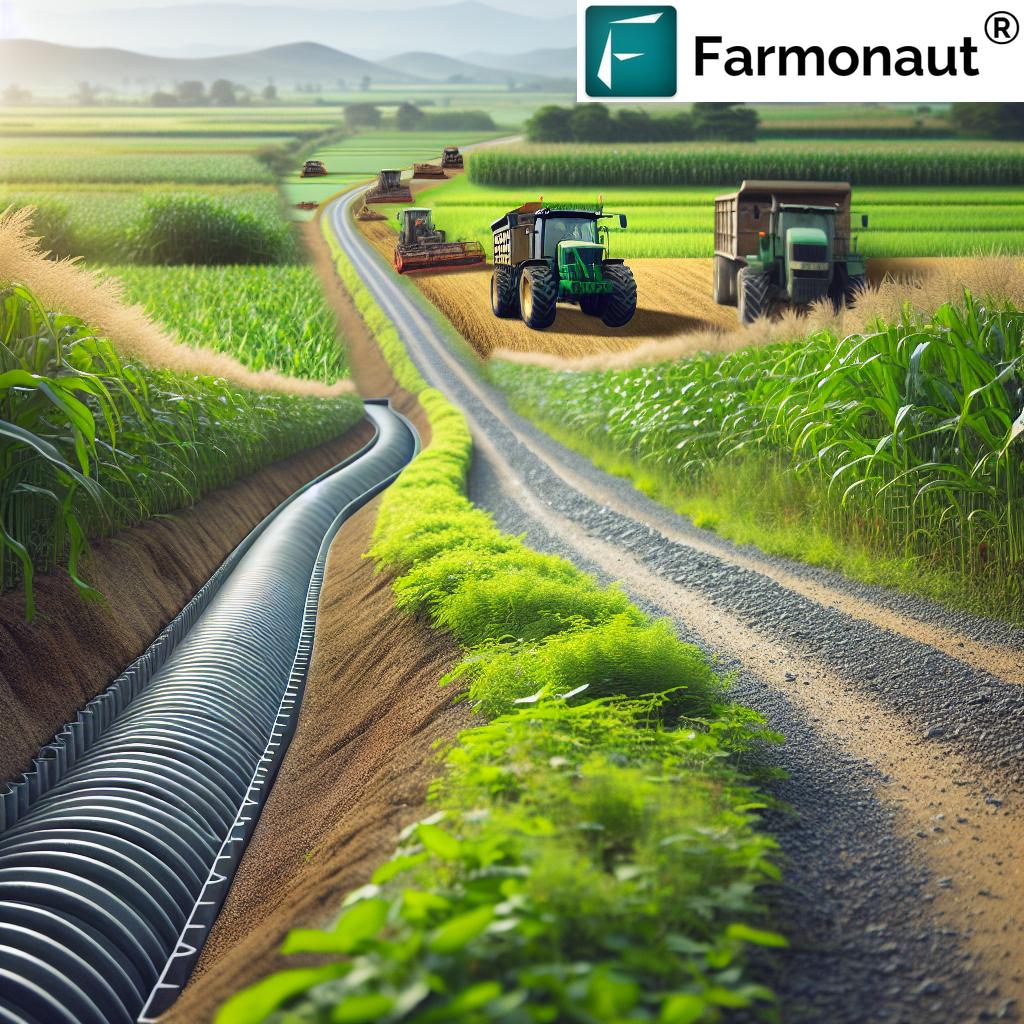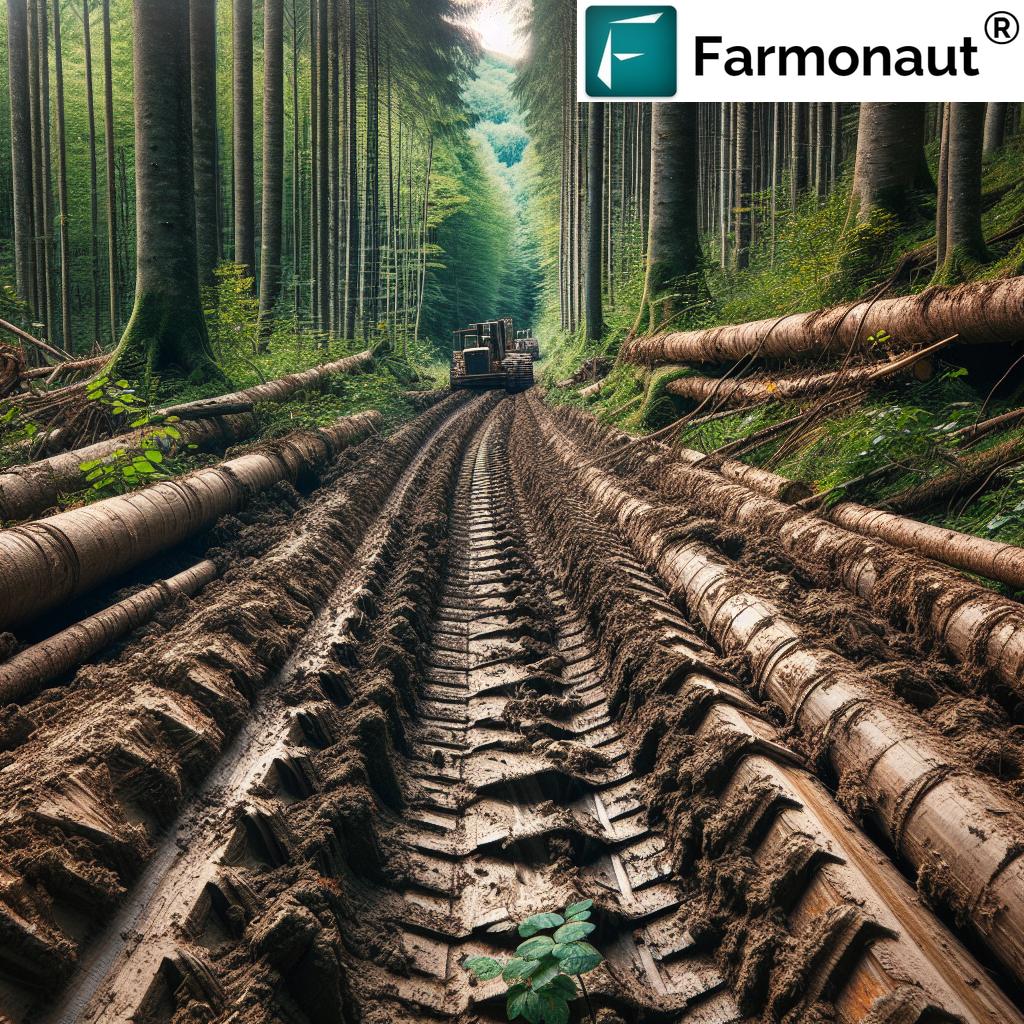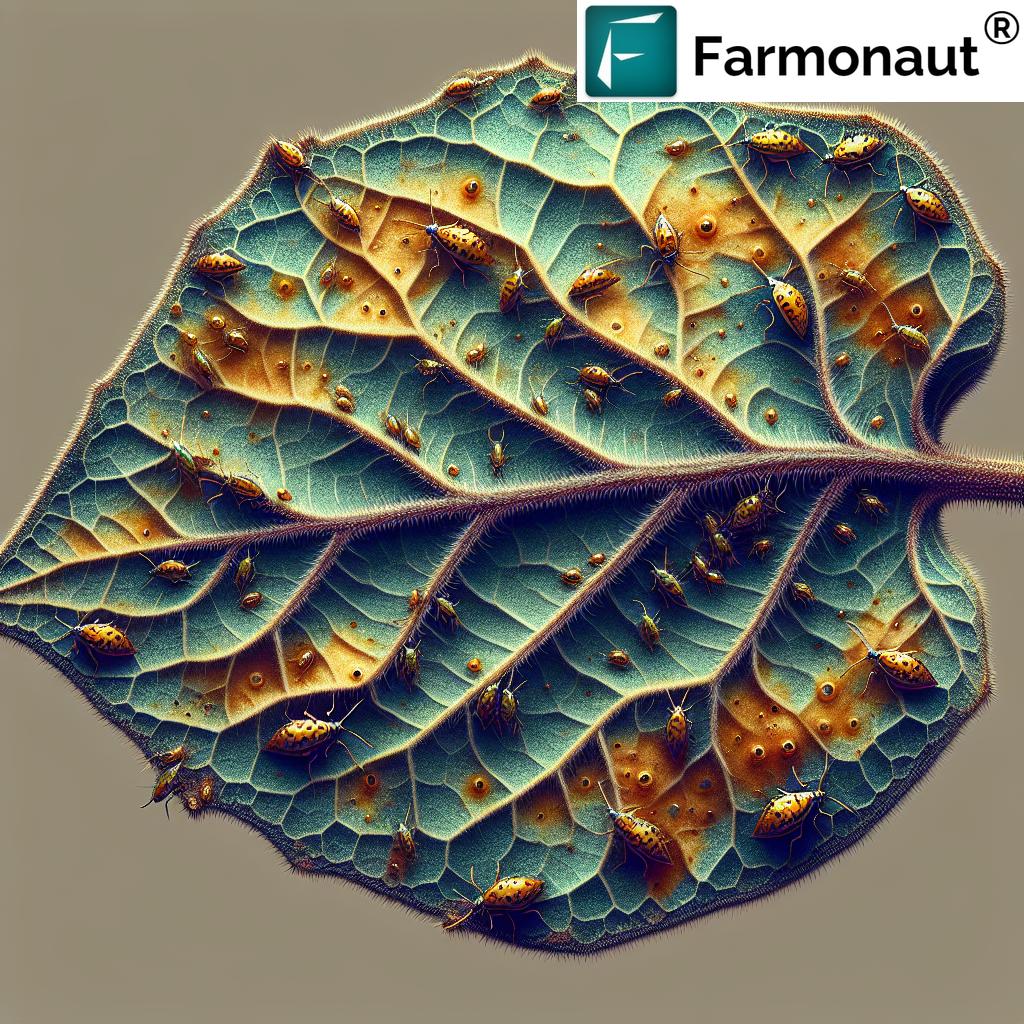What Are the Uses of Farm Track: 7 Efficient Ways
Discover how farm track maintenance, soil compaction prevention, and sustainable agricultural road design boost efficiency, yields, and environmental health. Learn how innovative technology and modern management practices transform farm tracks into essential pillars of productive and sustainable farming.
- Introduction: The Backbone of Modern Farming – Why Farm Tracks Matter
- Farm Track Design and Construction: Principles for Efficiency and Longevity
- The 7 Efficient Uses of Farm Tracks
- Farm Tracks at a Glance: Comparative Benefits & Impact Summary
- Soil Health, Erosion, and Yield: Impact of Farm Track Practices
- Sustainable Agricultural Road Design and Environmental Considerations
- Technology and Innovation in Farm Track Management
- Farm Track Maintenance: Ensuring Longevity and Efficiency
- Economic Impact of Well-Designed Farm Tracks
- Farmonaut Subscription Plans: Affordable Access to Precision Agriculture
- Frequently Asked Questions (FAQ)
- Conclusion: Transforming Agriculture with Smart Farm Tracks
“Well-designed farm tracks can reduce machinery fuel consumption by up to 15%, enhancing operational efficiency and sustainability.”
Introduction: The Backbone of Modern Farming – Why Farm Tracks Matter
In the realm of agriculture and forestry, every operational step counts toward maximizing yields, ensuring efficient movement, and maintaining soil health. At the heart of these daily activities are farm tracks—commonly known as agricultural roads, farm-to-market roads, or unpaved farm tracks. These components, which may seem unassuming at first glance, are in fact essential to the smooth execution of planting, crop maintenance, harvesting, and produce movement. Farm track maintenance, soil compaction prevention, and sustainable agricultural road design not only impact the immediate farm operations but also the very foundation of long-term environmental health and economic viability.
Modern technologies and data-driven insights, such as those offered by Farmonaut, empower farmers and agricultural managers to rethink how we plan, build, use, and maintain these critical routes. We will explore the seven most efficient ways to use farm tracks, their design principles, their direct and indirect impact on productivity and sustainability, and how digital innovation and remote monitoring are transforming farm track management.
Farm Track Design and Construction: Principles for Efficiency and Longevity
The design and construction of farm tracks are not “one size fits all.” Instead, these processes are tailored to the unique needs, topography, soil types, and operational demands of each property. Proper planning ensures that farm tracks provide safe, efficient, and durable access routes for even the largest agricultural equipment, while minimizing their footprint on soil health and the surrounding environment.
Key Considerations in Agricultural Road Design
- Width and Alignment: Tracks must be wide enough to accommodate all farm machinery and equipment (such as tractors and harvesters) and designed with gentle curves to prevent sharp turns that could damage soil structure or cause accident risks.
- Surface Material: The choice of surface material—unpaved earth, gravel, or crushed stone—affects everything from drainage and durability to long-term maintenance frequency.
- Drainage Solutions: Drainage systems such as ditches, culverts, and crown shaping prevent water accumulation (a major cause of erosion and track degradation), and are vital for erosion control in farming.
- Load and Traffic Considerations: Anticipated traffic load (machinery weight and frequency) dictates the structural integrity requirements and guides whether reinforcement is needed in specific segments.
- Integrating Technology: Today, techniques like GPS planning and Farmonaut’s large scale farm management tools enable precise, efficient agricultural road design and track routing across complex landscapes.
By embracing these modern design strategies, we not only ensure operational efficiency but also support soil compaction prevention and optimize for sustainability in the broader context of modern agriculture.
“Proper farm track maintenance can decrease soil compaction by 30%, directly improving crop yields and soil health.”
The 7 Efficient Uses of Farm Tracks
Let’s break down the seven most efficient ways that farm tracks drive agricultural and forestry success:
-
1. Facilitating Farm Machinery Access Routes
Farm tracks provide essential routes for tractors, harvesters, and other heavy equipment. Smooth, well-aligned roads ensure that we can mobilize machinery efficiently for planting, cultivation, spraying, and harvesting. Timely field operations become feasible even after rain or amidst seasonally challenging conditions, minimizing downtime and maximizing operational efficiency.
Farmonaut’s fleet management tools help us track machinery movements, schedule usage, and reduce fuel consumption—further boosting efficiency and sustainability.
-
2. Transporting Produce and Agricultural Products
Farm tracks connect fields with storage facilities, loading points, and rural towns, making efficient transport of harvested crops and livestock products possible. Well-maintained tracks help us reduce post-harvest losses, cut transport costs, and ensure that our produce reaches markets on time—an essential aspect for keeping up with market demands and consumer expectations.
- Unpaved farm tracks are particularly crucial in rural regions, where paved infrastructure may be limited, and every minute matters in perishable produce logistics.
-
3. Accessing Remote Areas and Fields
Large farms and forestry lands often have plots spread across remote or difficult terrains. Strategically constructed farm tracks facilitate access to these regions for irrigation system checks, crop monitoring, precision agriculture activities, and pest/disease scouting.
For example, precise resource application—driven by real-time crop health monitoring through Farmonaut’s platform—requires reliable movement routes even in the farthest corners of our property.
-
4. Supporting Forestry Operations Access Roads
Farm tracks are pivotal for transporting logs and timber from harvesting sites to processing facilities in forestry. They also enable forest management activities such as thinning, replanting, fire prevention, and environmental monitoring. Access roads built with erosion control measures help preserve forest ecosystem health while supporting efficient forestry operations.
-
5. Soil Compaction Prevention and Erosion Control in Farming
Unstructured farm traffic can devastate soil structure—leading to soil compaction, which restricts water infiltration and root growth. By carefully designing and maintaining defined farm tracks, we implement controlled traffic farming. This limits compaction to track zones, leaving most field soil loose and productive. Similarly, erosion control measures such as crowned surfaces and side ditches prevent water runoff and safeguard against the loss of vital topsoil.
Farmonaut’s carbon footprinting feature enables us to track the environmental benefits of reduced compaction and erosion—further aligning operational strategy with sustainability goals.
-
6. Supporting Sustainable Practices and Wildlife Habitat Preservation
Sustainable agricultural road design aims to minimize disruption to natural habitats and preserve wildlife corridors. Tracks can be planned to avoid critical ecosystem areas, while water diversion structures and native grass planting further mitigate erosion and runoff. With blockchain-based product traceability from Farmonaut, we can document and share our responsible farming practices with the entire supply chain, building transparency and trust.
-
7. Enabling Crop Yield Optimization through Precision Traffic Management
Optimizing the timing, placement, and frequency of farm traffic directly impacts field productivity. Efficient tracks allow for precise resource application (fertilizer, irrigation, crop protection) without creating unnecessary field compaction zones. Real-time data from Farmonaut’s crop health monitoring and AI advisory systems ensure that we respond to critical crop needs at exactly the right time—maximizing yield potential across the farm.
Learn about our mobile and web app access here to embrace precision management for your own operations.
Farm Tracks at a Glance: Comparative Benefits & Impact Summary
| Use/Application | Key Benefit | Estimated Yield Improvement (%) | Environmental Impact Score | Maintenance Frequency (Times/Year) |
|---|---|---|---|---|
| Facilitating Machinery Access Routes | Efficient, timely operations | +7% | Medium | 2 – 4 |
| Transporting Produce & Products | Reduced post-harvest losses | +5% | Low | 2 – 3 |
| Access to Remote Areas | Full land utilization | +3% | Low | 1 – 2 |
| Forestry Operations Access Roads | Improved forest management | +6% | Medium | 2 – 4 |
| Soil Compaction Prevention & Erosion Control | Enhanced soil health | +10% | Low | 3 – 5 |
| Sustainable Practices & Wildlife Preservation | Biodiversity support | +2% | Low | 1 – 2 |
| Crop Yield Optimization | Targeted resource use & traffic management | +12% | Low | 3 – 5 |
Soil Health, Erosion, and Yield: Impact of Farm Track Practices
Soil Compaction: A Hidden Yield Killer
We know from both research and field experience that soil compaction has a substantial impact on crop yields. Compacted soils restrict root development, water infiltration, and oxygen movement. Over time, this reduces soil fertility and hinders plant growth.
- By implementing controlled traffic farming—in which machinery travels in designated track lanes only—we can keep over 80% of field soil uncompacted and productive.
- As a result, this approach can raise crop yields by as much as 10% (see table above), strengthen root systems, and boost resilience against drought.
Erosion Control in Farming
Poorly designed or degraded tracks become “channels” for water runoff, causing erosion and topsoil loss—particularly on sloped or hilly terrain. By integrating drainage solutions for agricultural tracks—ditches, side-crowns, and vegetated buffers—we prevent water accumulation, reduce runoff velocity, and keep valuable topsoil on-site. These measures are critical for maintaining long-term field productivity and sustainability.
Sustainable Agricultural Road Design and Environmental Considerations
Farm tracks should advance productivity without sacrificing environmental health. This means embedding sustainability, soil preservation, erosion control, and biodiversity measures into every aspect of their planning, construction, and use.
- Wildlife Habitat Preservation: By locating farm tracks away from sensitive habitats and using ecological crossings where needed, we protect local wildlife and maintain ecosystem connectivity.
- Pollution Control: Keeping track surfaces clean, collecting any spilled oil, fuel, or chemicals (especially where machinery is parked or loaded) reduces the risk of water contamination.
- Native Grass Buffers: Planting perennial grasses on track margins further reduces sediment loss, filters runoff, and supports beneficial insects.
Modern sustainable farm track management is enhanced further by metrics-driven tracking, such as through Farmonaut’s carbon footprinting service, which enables farms to quantify and prove their environmental protection measures for buyers, regulators, and consumers alike.
Technology and Innovation in Farm Track Management
Digital technologies—from remote sensing to AI-driven advisory systems—are paving the way for smart farm track management. Here’s how we can leverage innovation for better outcomes:
Satellite-Based Crop and Track Monitoring
- Farmonaut’s multispectral satellite imagery delivers real-time crop health data, soil moisture analytics, and operational insights directly to our devices. This enables proactive responses for both field and infrastructure management.
Fleet and Route Optimization with GPS Tracking
- By fitting machinery with GPS tracking and telematics, we can monitor equipment location, optimize traffic flows, reduce idle time, lower fuel consumption, and proactively plan maintenance for both fleet and tracks.
- Explore Farmonaut’s Fleet Management to see how digital tracking can reshape your operational efficiency.
AI-Driven Advisory and Sustainable Practices
- Farmonaut’s Jeevn AI System analyzes satellite and weather data to deliver personalized crop advisory—from pest alerts to irrigation optimization—helping us make data-driven decisions about equipment movement and track use.
Blockchain for Traceability and Environmental Assurance
- Blockchain-based traceability solutions from Farmonaut let agribusinesses document every stage of the farm-to-table journey, including evidence of sustainable track and field management. Learn how traceability builds supply chain integrity.
All these technologies are available through Farmonaut’s suite of web, Android, and iOS apps—making precision agriculture affordable, scalable, and available anywhere in the world.
API Access:
Integrate Farmonaut’s satellite and weather APIs for farm track management into your in-house or enterprise systems.
Developer Documentation:
See the API developer docs for more on setup and implementation.
Farm Track Maintenance: Ensuring Longevity and Efficiency
Routine maintenance is vital for keeping farm tracks functional, preventing surface degradation, stopping water accumulation, and ensuring safety. Here’s how we can prolong their service life and effectiveness:
- Regular Inspection: Schedule walk-throughs to detect erosion, compaction, rutting, or water pooling before issues escalate.
- Surface Repair: Grading, patching, and resurfacing keep the track surface smooth for farm machinery.
- Drainage Management: Keep culverts, cross-drains, and ditches clear to prevent overflow and water damage.
- Vegetation Management: Side verges should be mowed and managed—minimizing encroachment while supporting grass buffers for erosion control.
Adopting a planned maintenance approach—with help from digital farm management solutions—delivers not only operational reliability but also cost savings over time.
Economic Impact of Well-Designed Farm Tracks
- Increased Efficiency: Streamlined movement for equipment and produce reduces operating costs and labor requirements.
- Extended Equipment Lifespan: Smooth, well-maintained tracks lower wear and tear on vehicles—saving on repair and replacement expenses. See the impact via fleet management analytics.
- Market Access Reliability: Consistent, year-round access to storage and market towns supports revenue stability, even in adverse weather or remote regions.
- Loan and Insurance Benefits: Satellite-verified track and field data from Farmonaut’s crop loan & insurance solutions help you access credit and manage risk more effectively.
All these factors together reinforce why investing in farm track maintenance and sustainable agricultural road design is not just a cost, but a direct contributor to productivity and long-term farm viability.
Farmonaut Subscription Plans: Affordable Access to Precision Agriculture
We believe that every grower, agribusiness, or forestry operation should have affordable, scalable access to satellite technology, AI advisory, and data-driven farm management. That’s why Farmonaut provides flexible subscription plans and API services to match your operational scale—whether you’re a small family farm or large enterprise.
Explore Farmonaut’s subscription options below. Plans cover real-time crop health monitoring, AI-driven advisory, resource tracking, and more for optimal farm track management and agricultural productivity:
Frequently Asked Questions (FAQ)
What are farm tracks and why are they important?
Farm tracks are specialized access roads (often unpaved or gravel) within agricultural or forestry properties. They are crucial for safe and efficient movement of machinery, produce, and people, directly influencing crop yields, soil health, and overall operational efficiency.
How does farm track maintenance impact crop yields?
Well-maintained tracks prevent soil compaction and erosion, reduce machinery downtime, and support timely resource application. These benefits can improve crop yields by up to 12% through better traffic management and soil health preservation.
What environmental considerations are involved in track planning?
Modern agricultural road design integrates erosion control, wildlife habitat preservation, pollutant runoff prevention, and low-impact siting—delivering both productivity and sustainability.
Can Farmonaut help with track planning and monitoring?
Yes. Farmonaut’s technologies—satellite-based crop and field monitoring, AI-driven advisory, and digital resource management—enable us to plan, monitor, and optimize both tracks and overall farm productivity from our computer or smartphone.
How often should we inspect and repair farm tracks?
Inspect tracks at least 2–4 times each year, with additional checks after heavy use or rainfall. Routine maintenance and repair can prevent small issues from turning into costly repairs or yield-limiting problems.
What software or apps are available for farm track management?
Farmonaut offers web, Android, and iOS apps for farm managers. These platforms support crop monitoring, resource tracking, field mapping, and advisory services, making comprehensive field and infrastructure management easier than ever.
How do farm tracks support sustainable agriculture?
By reducing machinery fuel use, protecting soil structure, ensuring safe water flow (drainage solutions), supporting biodiversity, and enabling smart, timely agricultural activities, farm tracks are a cornerstone of sustainability in modern farming and forestry.
Conclusion: Transforming Agriculture with Smart Farm Tracks
Farm tracks are not merely connecting lines on a property map—they are engines of productivity, sustainability, and operational resilience. Their role in facilitating equipment movement, supporting market transport, preventing compaction and erosion, and optimizing yield cannot be overstated. When combined with technological innovation, regular maintenance, and sustainable management, farm tracks enable us to unlock the full potential of every hectare. Platforms like Farmonaut make precision agriculture, sustainable design, and advanced track management affordable and accessible worldwide.
We encourage every agricultural professional, farm manager, and forestry operator to invest in smart farm track systems, modern tools, and sustainable strategies. Doing so will not only enhance daily efficiency and profitability but also safeguard the health of our land for generations to come.














